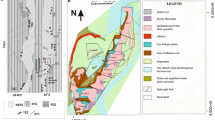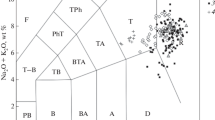Abstract
Detailed melt and fluid inclusion studies in quartz hosts from the Variscan Ehrenfriedersdorf complex revealed that ongoing fractional crystallization of the highly evolved H2O-, B-, and F-rich granite magma produced a pegmatite melt, which started to separate into two immiscible phases at about 720°C, 100 MPa. With cooling and further chemical evolution, the immiscibilty field expanded. Two conjugate melts, a peraluminous one and a peralkaline one, coexisted down to temperatures of about 490°C. Additionally, high-salinity brine exsolved throughout the pegmatitic stage, along with low-density vapor. Towards lower temperatures, a hydrothermal system gradually developed. Boiling processes occurred between 450 and 400°C, increasing the salinities of hydrothermal fluids at this stage. Below, the late hydrothermal stage is dominated by low-salinity fluids. Using a combination of synchrotron radiation-induced X-ray fluorescence analysis and Raman spectroscopy, the concentration of trace elements (Mn, Fe, Zn, As, Sb, Rb, Cs, Sr, Zr, Nb, Ta, Ag, Sn, Ta, W, rare earth elements (REE), and Cu) was determined in 52 melt and 8 fluid inclusions that are representative of distinct stages from 720°C down to 380°C. Homogenization temperatures and water contents of both melt and fluid inclusions are used to estimate trapping temperatures, thus revealing the evolutionary stage during the process. Trace elements are partitioned in different proportions between the two pegmatite melts, high-salinity brines and exsolving vapors. Concentrations are strongly shifted by co ncomitant crystallization and precipitation of ore-forming minerals. For example, pegmatite melts at the initial stage (700°C) have about 1,600 ppm of Sn. Concentrations in both melts decrease towards lower temperatures due to the crystallization of cassiterite between 650 and 550°C. Tin is preferentially fractionated into the peralkaline melt by a factor of 2–3. While the last pegmatite melts are low in Sn (64 ppm at 500°C), early hydrothermal fluids become again enriched with about 800 ppm of Sn at the boiling stage. A sudden drop in late hydrothermal fluids (23 ppm of Sn at 370°C) results from precipitation of another cassiterite generation between 400 and 370°C. Zinc concentrations in peraluminous melts are low (some tens of parts per million) and are not correlated with temperature. In coexisting peralkaline melts and high-T brines, they are higher by a factor of 2–3. Zinc continuously increases in hydrothermal fluids (3,000 ppm at 400°C), where the precipitation of sphalerite starts. The main removal of Zn from the fluid system occurs at lower temperatures. Similarly, melt and fluid inclusion concentrations of many other trace elements directly reflect the crystallization and precipitation history of minerals at distinctive temperatures or temperature windows.










Similar content being viewed by others
References
Anderson AJ, Bodnar RJ (1993) An adaptation of the spindle stage for geometric analysis of fluid inclusions. Am Mineral 78:657–664
Audétat A, Pettke T (2003) The magmatic-hydrothermal evolution of two barren granites: a melt and fluid inclusion study of the Rito del Medio and Caòada Pinatebe plutons in northern New Mexico (USA). Geochim Cosmochim Acta 67:97–121
Dahm KP, Thomas R (1985) Ein neues Modell zur Genese der Zinnlagerstätten im Erzgebirge (Quarz-Kassiterit-Formation). Freib Forsch.hefte, C 390:254–274
Diamond LW (2001) Review of the systematics of CO2-H2O fluid inclusions. Lithos 55:69–99
Falkenberg G, Rickers K (2002) Pink beam and monochromatic micro-X-ray fluorescence analysis at the beamline L. HASYLAB Annual Report, pp 88–95
Förster HJ, Tischendorf G, Trumbull RB, Gottesmann B (1999) Late collisional granites in the Variscan Erzgebirge, Germany. J Petrol 40:1613–1645
Kamenetsky VS, van Achterbergh E, Ryan CG, Naumov VB, Mernagh TP, Davidson P (2002) Extreme chemical heterogeneity of granite-derived hydrothermal fluids: an example from inclusions in a single crystal of miarolitic quartz. Geology 30:459–462
Kamenetsky VS, Naumov VB, Davidson P, van Achterbergh E, Ryan CG (2004) Immiscibility between silicate magmas and aqueous fluids: a melt inclusion pursuit into the magmatic-hydrothermal transition in the Omsukchan Granite (NE Russia). Chem Geol 210:73–90
Lechtenberg F, Garbe S, Bauch J, Dingwell DB, Freitag J, Haller M, Hansteen TH, Ippach P, Knöchel A, Radke M, Romano C, Sachs PM, Schmincke HU, Ullrich HJ (1996) The X-ray fluorescence measurement place at beamline L of Hasylab. J Trace Microprobe Tech 14:561–587
Linnen RL (1998) The solubility of Nb-Ta-Zr-W in granitic melts with Li and Li+F: constraints for mineralization in rare metal granites and pegmatites. Econ Geol 93:1013–1025
Linnen RL, Keppler H (1997) Columbite solubility in granitic melts: consequences for the enrichment and fractionation of Nb and Ta in the Earth’s crust. Contrib Mineral Petrol 128:213–227
London D (1992) The application of experimental petrology to the genesis and crystallization of granitic pegmatites. Can Mineral 30:499–540
London D (1999) Melt boundary layers and the growth of pegmatite textures. Can Mineral 37:826–827
Lowenstern JB (2003) Melt inclusions come of age: volatiles, volcanoes, and Sorby’s legacy. In: De Vivo B, Bodnar RJ (eds) Melt inclusions in volcanic systems—methods, applications and problems. Elsevier, Amsterdam, pp 1–21
Naumov VB (1979) Determination of concentration and pressure of volatiles in magmas from inclusions in minerals. Geochem Int 16:33–40
Rickers K, Thomas R, Heinrich W (2004) Trace-element analysis of individual synthetic and natural fluid inclusions with synchrotron radiation XRF using Monte Carlo simulations for quantification. Eur J Mineral 16:23–35
Roedder E (1984) Fluid inclusions. Reviews in mineralogy, vol 12. Mineralogical Society of America, Washington, DC, p 644
Roedder E (1992) Fluid inclusion evidence for immiscibility in magmatic differentiation. Geochim Cosmochim Acta 56:5–20
Roedder E (2003) Significance of melt inclusions. In: De Vivo B, Bodnar RJ (eds) Melt inclusions in volcanic systems — methods, applications and problems. Elsevier, Amsterdam, pp XV–XVII
Sheppard SMF (1994) Stable isotope and fluid inclusion evidence for the origin and evolution of Hercynian mineralizing fluids. In: Seltmann R, Kämpf H, Möller P (eds) Metallogeny of collisional orogens. Czech Geological Survey, Prague, pp 49–60
Thomas R (1982) Ergebnisse der thermobarogeochemischen Untersuchungen an Flüssigkeitseinschlüssen in Mineralen der postmagmatischen Zinn-Wolfram-Mineralisation des Erzgebirges. Freib Forsch.hefte, C 370:1–85
Thomas R (2000) Determination of water contents of granite melt inclusions by confocal laser Raman microprobe spectroscopy. Am Mineral 85:868–872
Thomas R (2002) Determination of the H3BO3 concentration in fluid and melt inclusions in granite pegmatites by laser Raman microprobe spectroscopy. Am Mineral 87:56–68
Thomas R, Webster JD (2000) Strong tin enrichment in a pegmatite-forming melt. Miner Depos 35:570–582
Thomas R, Webster JD, Heinrich W (2000) Melt inclusions in pegmatite quartz: complete miscibility between silicate melts and hydrous fluids at low pressure. Contrib Mineral Petrol 139:394−401
Thomas R, Webster JD, Rhede D, Seifert W, Rickers K, Förster HJ, Heinrich W, Davidson P (2006) The transition from peraluminous to peralkaline granitic melts: evidence from melt inclusions and accessory minerals. Lithos (in press)
Thomas R, Förster HJ, Heinrich W (2003) The behaviour of boron in a peraluminous granite-pegmatite system and associated hydrothermal solutions: a melt and fluid-inclusion study. Contrib Mineral Petrol 144:457–472
Thomas R, Förster HJ, Rickers K, Webster J (2005) Formation of extremely F-rich hydrous melt fractions and hydrothermal fluids during differentiation of highly evolved tin-granite magmas: a melt/fluid inclusion study. Contrib Mineral Petrol 148:582–641
van Espen P, Janssens K, Swenters I (1992) AXIL X-ray analysis software. Manual and computer program. University of Antwerp, Antwerp
Vekemans B, Janssens K, Vincze L, Adams F, van Espen P (1995) Comparison of several background compensation methods useful for evaluation of energy-dispersive X-ray fluorescence spectra. Spectrochim Acta B Atom Spectrosc 50:149–169
Vekemans B, Janssens K, Vincze L, Adams F, van Espen P (2004) Analysis of X-ray spectra by iterative least squares (AXIL): new developments. X-ray Spectrom 23:278–285
Veksler IV, Dorfman AM, Dingwell DB, Zotov N (2002a) Element partitioning between immiscible borosilicate liquids: a high-temperature centrifuge study. Geochim Cosmochim Acta 66:2603–2614
Veksler IV, Thomas R, Schmidt C (2002b) Experimental evidence of three coexisting immiscible fluids in synthetic granitic pegmatite. Am Mineral 87:775–779
Vincze L, Janssens K, Adams F (1993) A general Monte Carlo simulation of energy-dispersive X-ray fluorescence spectrometers — part I. Spectrochim Acta B Atom Spectrosc 48:553–573
Vincze L, Janssens K, Adams F, Rindby A (1995a) A detailed ray-tracing code for capillary X-ray optics. X-ray Spectrom 24:27–37
Vincze L, Janssens K, Adams F, Rivers ML, Jones KW (1995b) A general Monte Carlo simulation of energy-dispersive X-ray fluorescence spectrometers — part II. Spectrochim Acta B Atom Spectrosc 50:127–148
Vincze L, Janssens K, Adams F, Jones, KW (1995c) A general Monte-Carlo simulation of energy dispersive X-ray fluorescence spectrometers — part III. Spectrochim Acta B Atom Spectrosc 50:1481–1500
Webster JD, Thomas R, Rhede D, Förster H-J, Seltmann R (1997) Melt inclusions in quartz from an evolved peraluminous pegmatite: geochemical evidence for strong tin enrichment in fluorine-rich and phosphorus-rich residual liquids. Geochim Cosmochim Acta 61:2589–2604
Webster JD, Thomas R, Förster HJ, Seltmann R, Tappen C (2004) Geochemical evolution of halogen-enriched, granite magmas and mineralising fluids of the Zinnwald tin-tungsten mining district, Erzgebirge, Germany. Miner Depos 39:452–472
Acknowledgements
The authors thank Christian Schmidt, Volker Lüders, Ilya Veksler, Max Wilke, Gerald Falkenberg, Laszlo Vincze, and Bart Vekemans for discussions and collaboration during this study. We are grateful to the Hamburger Synchrotronstrahlungslabor for beamtime at beamline L and to the Geoforschungszentrum for support of this study. Editorial handling by Bernd Lehmann and Robert Moritz is highly appreciated. We thank Robert Linnen and Dima Kamenetsky for their constructive and helpful reviews.
Author information
Authors and Affiliations
Corresponding author
Additional information
Editorial handling: R. Moritz
Rights and permissions
About this article
Cite this article
Rickers, K., Thomas, R. & Heinrich, W. The behavior of trace elements during the chemical evolution of the H2O-, B-, and F-rich granite–pegmatite–hydrothermal system at Ehrenfriedersdorf, Germany: a SXRF study of melt and fluid inclusions. Miner Deposita 41, 229–245 (2006). https://doi.org/10.1007/s00126-006-0057-7
Received:
Accepted:
Published:
Issue Date:
DOI: https://doi.org/10.1007/s00126-006-0057-7




